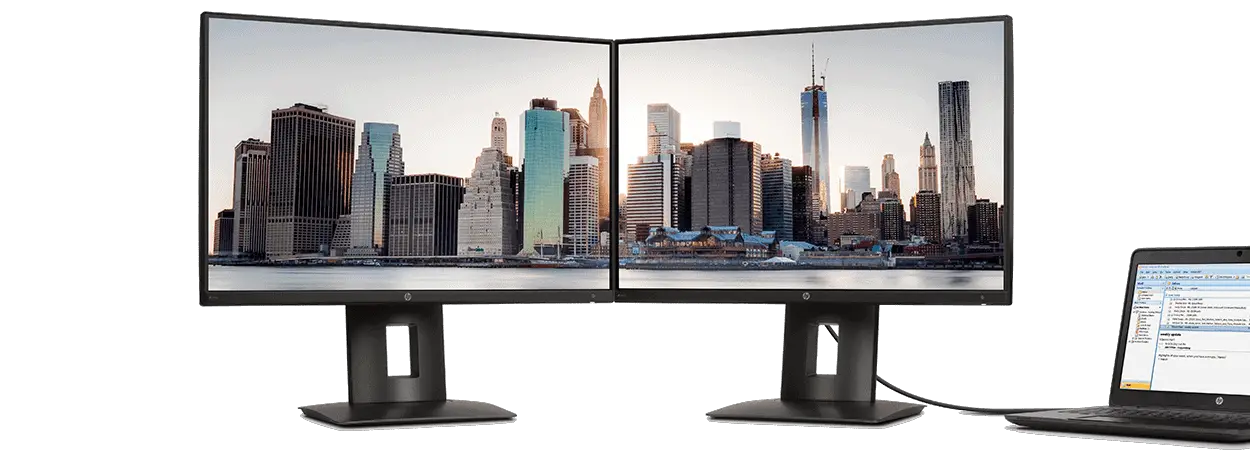Having dual monitors is a great way to view multiple windows side-by-side or to have one monitor dedicated to working and the other for entertainment. But why stop there? With just a few steps, you can make your dual monitor setup even more unique by setting different wallpapers for each display. This article will cover setting other wallpapers on dual monitors in Windows 10 and below. We will also provide you with steps to do that in Windows 11.
Can I have different backgrounds on the dual monitors?
You can have different backgrounds on the dual monitors and set other wallpapers on each. You need to download different wallpapers for each monitor background and apply them separately using the option “Set as Wallpaper”r” in Windows 11″ or Personalization Background in Windows 10.
Learn How to Change Mouse Direction on Dual Monitors in our article.

Before doing anything else, check if your displays are appropriately connected and functioning. You should see both of them listed in the Display Settings window. To open it, right-click a space on your desktop and select “Display Settings” from the cont” tx menu. Once you’ve confirmed that you’ve all been good with your dual monitor setup, it’s time to select two distinct wallpapers for them.
Finding Wallpapers
You can choose any wallpaper you want – like a photograph you took, an image of the web, or preloaded ones included with Windows 10. It doesn’t matter where they come from as long as they look good on both displays. To look for suitable backgrounds, go to the Display Settings window and click “Choose an image” or color” near the top “of the page under one of your monitors’ it will open up a list of available images, including preloaded ones and photos taken with your devices camera device’s saved under the Documents\Pictures folder (if applicable).
Steps on how to add the different backgrounds in Windows 10 for dual monitors:
- Setting Wallpapers Now that you’ve found two background images for each monitor, it’s time to suit up correctly:
- Right-click a space on your desktop again and select “Personalize” f” om the cont”xt menu;
- Click “Desktop Backgr” und” near the bott”m left corner of the Personalization window;
- Find both images you want to use under the Choose Your Picture section;
- Under the Position dropdown menu next to each picture, select the Span option;
- Finally, click the Save Changes button at the bottom right corner of this window;
- Both images should be displayed correctly across both displays without distortions or overlapping elements.
And that’s it! You’that’scessfYou’veonfigured different wallpapers for each display in Windows 10 (or earlier versions). If you ever want to revert to using a single wallpaper across both screens again, repeat steps 1–4 above. This time, choose Fill instead of Span under the Position dropdown menu for both pictures before saving changes at step 5.
How to set different wallpapers (backgrounds) on dual monitors in Windows 11?
- Download a multi-monitor wallpaper: There are several websites where you can find wallpapers across both monitors, such as Dual Monitor Backgrounds. Choose the one that best suits your needs.
- Right-click on each monitor and select ‘Set As Wallpap’r’: A menu shoul’ appear when you right-click on either of your monitors. Select ‘Set As Wallpap’r’ to apply the ‘allpaper to both monitors.
- Adjust image settings if needed: The image may be too small or too large for your monitors. You can adjust the settings by clicking ‘AdvancedSettings’ in the right-click menu. From there, you can adjust the image size and how it is cropped for each monitor.
- Use multiple images for each monitor: If you prefer a different image, download two separate wallpapers and apply them separately to each screen using the same method above.
- Try out animated backgrounds: For a more dynamic experience, try animated wallpapers from sites like Wallpaper Engine or Rainmeter Skins. These will allow you to set up cool, moving backgrounds across both monitors simultaneously!
- Create your multi-monitor wallpaper: If none of the available wallpapers suit your needs or tastes, why not create one yourself? All you need is an image editing program like Photoshop and creativity! Cut up an existing image into two parts (one per monitor) and assemble them until they form a cohesive whole.
- Facebook Ads to Get Followers! - December 27, 2024
- ClickUp vs. Slack - December 20, 2024
- Mastering E-Commerce Analytics: A Blueprint for Success





